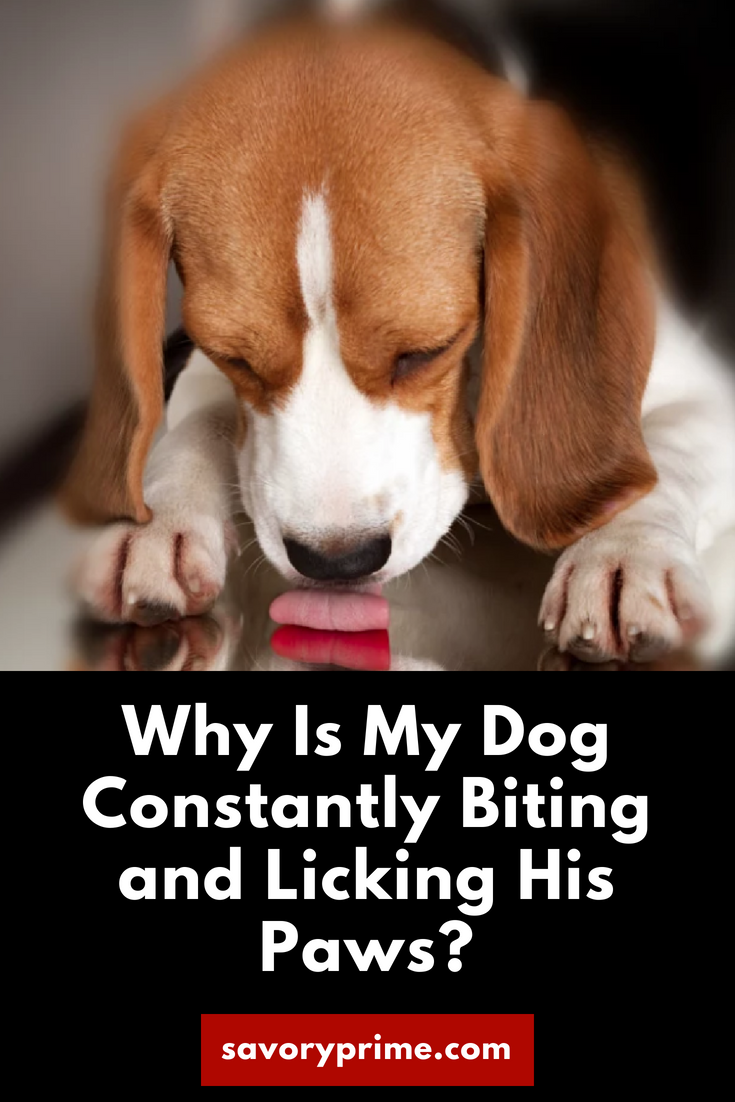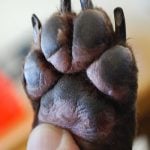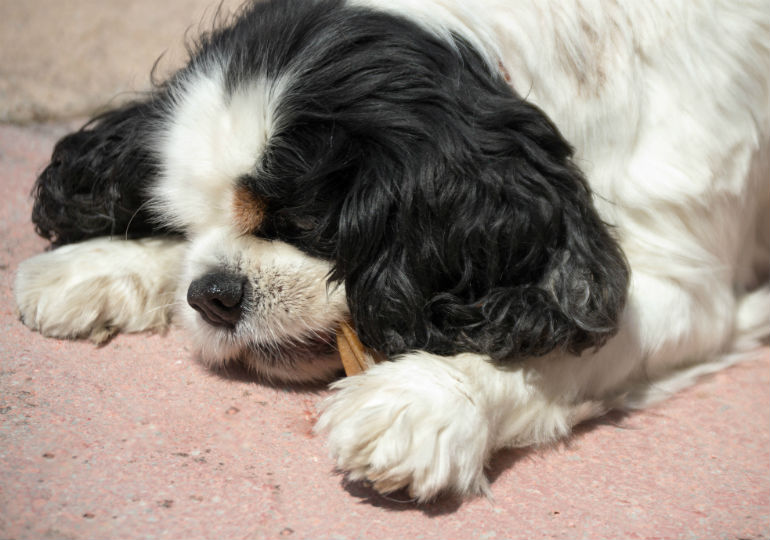Does your fur baby constantly bite and lick his paws? If you answered yes, you’re not alone. I can tell you this from personal experience. Lately, every time I turn around, I hear my dog gnawing away at her paw-pads and munching on her nails. As a concerned pet parent, I always want to make sure she is comfortable and healthy. I’m sure you do too! To help comfort your dog, though, you must first figure out why she is chowing down on her tootsies.
Why Is My Dog Chewing His Paws?
The most common cause of dogs constantly chewing their paws and nails is atopy or atopic dermatitis. Simply put … allergies!
What is Atopic Dermatitis?
Atopic Dermatitis is a chronic skin condition brought on by an inflammatory response from inhaled (atopy) environmental exposure to allergens. A dog will chew and lick to try and relieve their itchy skin. It is a chronic skin disorder and it is genetic. Atopic dermatitis usually occurs in the first few years of life, somewhere between a few months old and 6 years of age. The condition can come and go, but it almost always comes back.
What Causes it?
The most common causes are due to molds, grasses, pollen, and dust mites. Just as a human can inhale allergens, so can little fido. Humans normally exhibit itchy eyes, runny noses, and respiratory symptoms, while dogs most often have symptoms of itchy paws, face, or ears.
Symptoms
Chronic Biting and licking paws due to itching
- Red and inflamed paw pads from excessive licking and chewing
- Brown saliva stains on paw pads due to excessive licking
- Scratching
- Shaking head and ears – ears can itch and/or become infected
- Runny nose and watery eyes can be present, but less frequently
- Be alert for any odors, open wounds, or skin breakdown from the excessive licking and chewing. These can be signs of infection and will need to be looked at by the vet.
Diagnosing allergies can be tricky. Your vet can do skin tests and blood tests to identify what your pup is allergic to. Depending on the severity, he may want to treat with steroids or antihistamines. Whether you want to go that route or not (I’ll talk about natural treatments in just a minute), it’s always a good idea to let your vet know what’s going on with your pup. With atopic dermatitis, you want to make sure that your pooch doesn’t wind up with a bacterial or yeast infection. So a trip to the vet is definitely warranted.
Natural Treatments To Try
- Of course, the first thing to do if you know the cause would be to remove the trigger. But since environmental causes are not that easy to remove, your best bet is to try and limit exposure.
- Consider putting a tee-shirt on your fur baby. It will put a barrier between his skin and the environment. Remember to wash and change it daily to remove lingering pollens.
- When your pooch comes in from the outside, wipe him down with a damp cloth to remove surface pollen. Wipe the face, paws, underside of the belly, underarms,groin, tail and anal/genital areas. These are the areas most prone to contact exposure while walking your pup.
- Rinse your dog’s paws after an outing. I do this in the summer months before bed every night when my pups allergies act up and she gets instant relief. I just run her little paws under cool water for a few minutes while massaging her feet and paw-pads. Then I dry her off with a towel. She curls up in the bed and happily goes to sleep. Total relief – no biting or licking those little tootsies.
- Give your dog a bath, but not more than every couple of weeks. You don’t want to dry his/her skin out. Bathing usually gives symptomatic relief and removes pollens from the skin. Use gentle formulas, hypoallergenic formulas, or a soothing oatmeal shampoo.
- Studies have shown that Omega-3 fatty acids may relieve atopic dermatitis. Speak to your vet about increasing fatty acids in your pup’s diet and possibly using an Omega-3 fatty acid supplement.
- Keep your carpets vacuumed, linens washed and changed to keep dust mites to a minimum.
- If you have an air filter, use it to help reduce airborne allergens within the home.
Recent Pet Posts
Blog Categories
Product categories
- Accessories (9)
- Chicken & Veggie Wraps (8)
- Grillers Jerky Tenders (4)
- Jerky Treats (10)
- Made in the USA (9)
- Non-Rawhide Treats (28)
- Beggar Bone (11)
- Bully Sticks (4)
- Butcher Bone (4)
- Cod Skin Fish Treats (3)
- Pork Skin Twists (2)
- Pressed Rawhide Bones & Rolls (16)
- Bones & Rolls (6)
- Pressed Rawhide Bulk (6)
- Twist Sticks (4)
- Savory Munchies (13)
- Supreme Bones & Rolls (48)
- American Rawhide Bulk (16)
- Rawhide Bones (14)
- Rawhide Chips (6)
- Rawhide Rolls & Sticks (12)
- Uncategorized (8)


 Chronic Biting and licking paws due to itching
Chronic Biting and licking paws due to itching
1 Comment. Leave new
THANK YOU SO MUCH❤️The answer is so under stable and the ways to give relief a child could almost help with supervision.